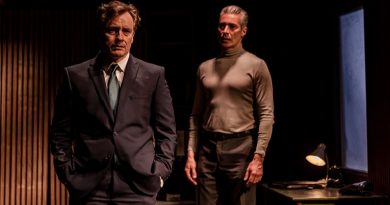“The American Clock” at the Old Vic
Jeremy Malies on the South Bank
14 February 2019
Twice in less than a year I’ve seen bankers during the 1929 crash committing suicide, firstly in The Lehman Trilogy and now in Arthur Miller’s unwieldy 1980 play The American Clock which has been revived at the Old Vic in a version directed by Rachel Chavkin.
The play closed early in its Broadway premiere run amid recriminations from Miller that the staging misrepresented his intended structure which is a memory play spanning the Thirties to the late Sixties. Events are seen through the experience of the Baum family (smacking much of Miller’s own back story) whose wealth is wiped out by the stock market collapse but who struggle through the Depression with fortitude and dignity.
Chavkin is a Tony Award winner who claims that she is motivated by the possibility of a play spiralling into chaos but ensures that her work is always tightly controlled. She has a steady hand here but a play whose grandiose scale should see it soar to the finale of the 1969 moon landing remains earthbound. The problem is that the wars, dysfunctional ideologies and social upheaval that characterize the twentieth century hardly lend themselves to being viewed through the lens of a single family.
As we flit from living room squabbles to an overview of national economics, the play begins to creak at the seams and it remains disjointed. The structural premise is logical; the Baums are trying to rebuild their finances, and through his New Deal, Roosevelt is trying to reclaim the country. Lengthy extracts from F.D.R.’s radio speeches (I never thought they could be so unengaging) are an integral part of the text as written but Darron L. West’s sound design could have reined them in and the approach is a lazy form of exposition.
Three sets of actors of different ethnicities play the Baum family as it morphs from white-Jewish to South Asian to African-American. In this way, Chavkin skilfully underlines that the central experiences cut through all strata of society. Despite her best endeavours, the macro and micro elements never gel, with the fault lying in Miller’s overall method.
Design is by Chloe Lamford whose work often has intricate detail and movement. Here, her predominant element is enormous chalkboards from the Wall Street Stock Exchange which stay with us throughout as a reminder that, even with subprime lending and toxic debt on the wane, yet another financial bubble may be forming under a president who is the apotheosis of capitalism. The thought that history might repeat itself is underlined by seeing characters on the Old Vic’s revolve. The set works well for a configuration somewhere between traverse and in the round.
The framing device is the reflective narrative voice is that of Clarke Peters (known for HBO dramas The Wire and Treme) but even with his technical resources and gravitas, the memory play element is clunky. There are of course some stand-out performances notably from Fred Haig who sings wonderfully while his character, an aspiring composer, pecks out a melody that he hopes will be a hit in Tin Pan Alley. The actor is the son of the writing and performing phenomenon that is David Haig. If there seemed to be a percussive trill accompanying the piano it was only the sound of Haig pere as he looked on from the stalls and purred contentedly. Haig brought a lyrical quality to his whole performance which was one of the evening’s few highlights.
The song and dance elements are in a different league to the dialogue. Musical director Jim Henson and three on-stage instrumentalists bring a freshness to what might have been tired numbers from the Great American Songbook and Ewan Wardrop (as president of General Motors no less) is hugely personable as he tap-dances with delicate slides and syncopation.
There are stodgy vignette scenes set outside New York in which we see enforced farm auctions by predatory banks and the near lynching of a judge. The production has got lucky in that the theme of popular uprising during the Depression echoes the current yellow vest protests. A few lines have acquired freight. “I thought they were all Republicans in Iowa” of a state that flipped for Trump in 2016 got the biggest laugh of the night from a mid-Atlantic audience.
This play was structurally unsound on its 1980 debut and remains so now. The grand panoramic sweep across five decades of American history lacks discipline and the critique of capitalism finally becomes saccharine. Unusually for a play with historical content, I came away feeling better informed but with the sense of having attended a lecture.
In April, the Old Vic will present Miller’s masterful All My Sons. There are similarities between the pieces in their treatments of World War Two, and The American Clock even touches on the all-important aviation supplies that are the focus of All My Sons. But the pairing has no real synergy, and why artistic director Matthew Warchus decided to revive this flawed work is beyond me.









